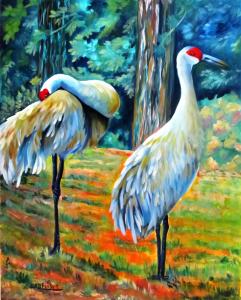Sale on canvas prints! Use code ABCXYZ at checkout for a special discount!

“On October 11, members of the Administrative Regulations Review Subcommittee voted unanimously, by a 7 to 0 vote, to approve a plan to allow sandhill crane hunting in the Bluegrass State. With this final approval, Kentucky will join thirteen other states in which sandhill cranes can be properly and scientifically managed through hunting.”
In spite of the efforts of many environmentalists, the approved sandhill crane hunting season is expected to begin December 17. Land east of the Mississippi has not seen sandhill cranes hunted in more than a century due to a decrease in the species’ population. Over the last three decades their population has grown more than 300 percent and Kentucky’s wildlife experts and biologists called for a hunting season that will help manage and conserve the species.
Many environmentalists believe in managed hunting to control a species, but in this case, the concern is that the sandhill cranes will be endangered once again. Their anxiety is over the accuracy of the increased numbers sited.
Do they eat them after being shot? Many of them do, and it is supposed to taste like any other game bird. From the killing of one large bird, only the breast meat is edible. Could I eat one? Never! That would be like Fern eating Wilbur in “Charlotte’s web.”
They live in our neighborhood. One used to knock on a neighbor’s back door and he would feed him seeds from his hand. This same bird would tease another neighbor’s dog by getting up close to the screened lanai. They adopted a friendly attachment to each other.
I have watched their babies toddle across the golf course out back. We see the same pairs mate and come back year after year. Shooting these beautiful birds is tantamount to killing a friend. I understand that sometimes hunting is a necessary evil, but please, not in my backyard.
My completed painting: “Sandhill Cranes at Twilight” shows the body plumage; characterized by varying shades of gray. “In many areas, wild Sandhills preen iron-rich mud into their feathers creating a deep rusty brown hue which lasts during spring and summer. As fall advances, these rusty feathers molt and the birds return to their grayish appearance. In some regions, however, iron-rich mud is absent and the birds appear grey all year. The forehead and crown are covered with reddish skin. Face, chin, upper throat, and nape are white to pale gray. Adults have a white cheek patch. Legs and toes are black. In general, males and females are virtually indistinguishable but within a breeding pair, males tend to be larger than females.
“All cranes are omnivorous. Sandhill Cranes are generalists and feed on a wide variety of plant tubers, grains, small vertebrates (e.g. mice and snakes), and invertebrates such as insects or worms. Sandhills find these foods in uplands and in shallow wetlands. Like most cranes, flightless chicks forage primarily on a diet of insects and other protein filled foods during their early stages of rapid growth. The Sandhill's tendency to feed on plant tubers creates conflicts with farming. Sandhill Cranes are adept at probing in the ground and finding planted agricultural seeds such as corn. When large flocks of cranes feed on planted fields, the damage they cause to an unprotected crop can be severe enough to force the farmer to replant the entire field.” www.allaboutbirds.org/guide/Sandhill_Crane/id.
This is the main reason for the crackdown. Farmers were losing their valuable crops to cranes. Scientists have developed a new technique for treating the seeds before they are planted. The cranes dislike the taste of the treatment so leave the seeds untouched, but first they forage for them and for other things under the soil causing damage. Some farmers have had to replant entire fields because of the destruction.
On a side note: “All cranes engage in dancing, which includes various behaviors such as bowing, jumping, running, stick or grass tossing, as well as wing flapping. Though it is commonly associated with courtship, dancing can occur at any age and season. Dancing is generally believed to be a normal part of motor development for cranes and thwarts aggression, relieves tension, and strengthens the pair bond.”